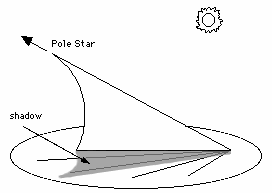Stretching gracefully across the Sacramento River in Redding, CA is this glass bottomed bridge opened in 2004. It is suspended by cables from the white tower structure. The tower is on the north shore of the river and is the gnomon of a sundial. The river is important for salmon spawning and by law is not to be disturbed by the structure. This work of art is by Spanish architect and engineer Santiago Calatrava. Read more about the designer and the bridge at this link. Visit this Google Maps view showing the north-south orientation of the structure.
 A simple and traditional design of a sundial involves a horizontal plate with a gnomon pointing toward the north star. In this version, the gnomon is a triangular shape. That makes no difference. It just needs to cast a shadow.
A simple and traditional design of a sundial involves a horizontal plate with a gnomon pointing toward the north star. In this version, the gnomon is a triangular shape. That makes no difference. It just needs to cast a shadow.
School children have made sundials for generations. The lessons use a wide variety of materials and styles. They all work. With a little care, tape, staples, scissors, paper, and glue, a functional sundial can be made such as this one. Here are directions if you want to try making one similar to this yourself.

I did some Googling around and collected some other interesting and unique examples of sundials around the world. I learned some local history along the way which I have added to the pictures. Join me below for the tour. It won’t take much of your time.
By the way, does anyone know what time it is?
☼ This 13 foot sundial is at the Adler Planetarium on the Chicago lakefront. It is by Henry Moore and was erected in 1980. It is called Man Enters the Cosmos. I like the Chicago skyline in the background. It is one of my favorite places in the city.

☼ Farther north in Canada we find this sundial. A person must be standing in place to provide the gnomon for the it to function. It is part of the Keppel Croft Gardens in Grey County, Ontario. There are some additional pictures and notes by the builder Steve Irvine at this link.

☼ Next, we travel to the Forbidden City in China. For scale, notice the people standing nearby. Here is a link to a larger image with a more comprehensive view of the sundial and its mount.
This sundial dates from the Ming Dynasty (1368-1644). It is located in front of the Hall of Supreme Harmony as a symbol that the Emperor was the source of the standards of time. Timekeeping is an important government function in any culture.

☼ San Francisco is the home to this sundial at Ingleside Terraces on Entrada Court. The gnomon is over 28 feet long. It was dedicated October 10, 1913. The Panama Canal ‘meeting of the waters‘ was also on that date. That is when a detonation allowed the Pacific and Atlantic waters to meet. The first official transit of the canal was on August 15, 1914.

☼ Sundials are not always large outdoor objects. This is a pocket sundial and compass from 1673. It resides in the Morristown National Historic Park. Made in France, the back is inscribed with ‘Roch blondeaux Paris 1673.’ Dimensions are 5.1 x 4.1 cm, about half the size of this image. It is made of silver and glass.

☼ Now for a sundial with a goal of precision and accuracy of 30 seconds. Made by Hoffmann Albin, Belgium. This link gives you all the details if you are interested in having one custom made. It is stainless steel, 30 cm in diameter, and delivered in 6 weeks. Price is just over $2000.

☼ This sundial is wall mounted on the side of the church at Eyam – the Derbyshire Plague Village. Follow the link for more about the plague and its effect on the village in 1665-1666. Eyam lost 260 lives out of a population of around 800 in fourteen months after deciding to quarantine the village to spare others. There is also a 10 min video of their story. The inscription on a plate below reads 1775.

☼ Last is this interesting sundial using water refraction as the gnomon. It needs to be adjusted as the sun progresses north and south through the seasons. Plus, it won’t work well in freezing climates without a healthy dose of anti-freeze.

Fonte: https://jarphys.wordpress.com



 A gnomon is a shaft that helps indicate time by the shadow it casts. They can be simple such as a stick in the ground, or highly ornate, as the one above. They can stand vertical, horizontal, or in between. They can be made of many different kinds of materials. How they are incorporated into a sundial design by the maker varies in thousands of ways, often very creatively.
A gnomon is a shaft that helps indicate time by the shadow it casts. They can be simple such as a stick in the ground, or highly ornate, as the one above. They can stand vertical, horizontal, or in between. They can be made of many different kinds of materials. How they are incorporated into a sundial design by the maker varies in thousands of ways, often very creatively.
Nenhum comentário:
Postar um comentário